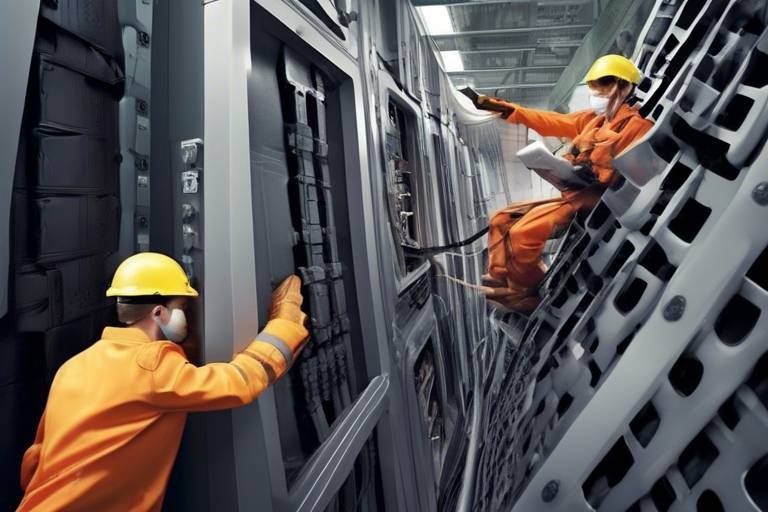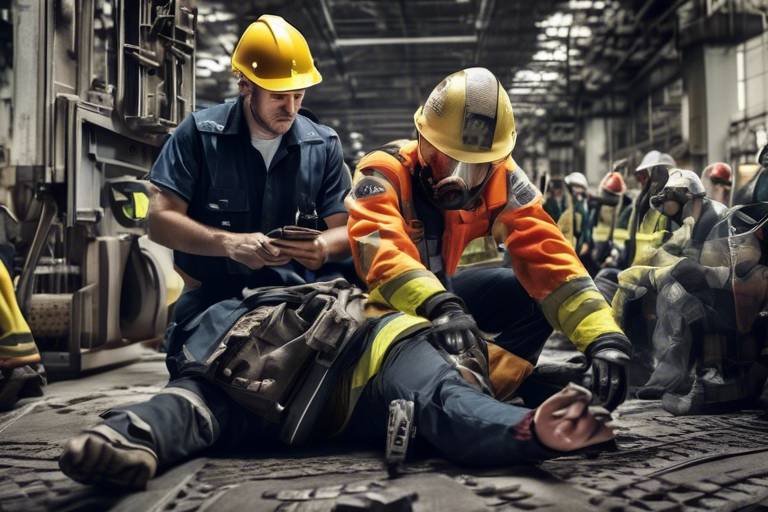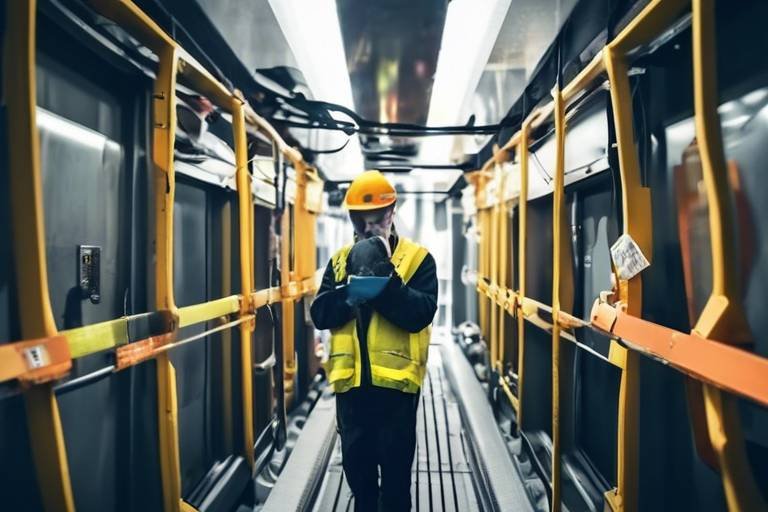A Shift in Safety Measures: The Role of Human Behavior
The landscape of safety measures is evolving, and at the heart of this transformation lies human behavior. It's no longer sufficient to merely install safety equipment or enforce regulations; we must delve deeper into the psychological and behavioral factors that influence how individuals respond to safety protocols. This article aims to explore the critical influence of human behavior on safety measures, emphasizing the need for behavioral insights to enhance safety protocols across various sectors.
Understanding human behavior is essential for developing effective safety measures. Consider this: in many environments, accidents occur not because of a lack of safety tools but due to human error. This phenomenon highlights the significance of human factors in safety outcomes. For instance, in high-risk industries like construction or manufacturing, the way workers perceive risks and respond to safety protocols can drastically alter the likelihood of accidents. By recognizing that human behavior is a variable in the safety equation, organizations can tailor their strategies to not only address physical safety but also the psychological aspects that drive behavior.
Behavioral psychology offers a treasure trove of insights into why individuals act in certain ways. It helps us understand that behavior is not just a product of external stimuli but also of internal motivations and perceptions. For example, when workers feel valued and understood, they are more likely to engage positively with safety measures. This section delves into psychological principles that can be applied to improve safety practices and decision-making processes within organizations.
Motivation plays a crucial role in safety compliance. Have you ever wondered why some people diligently follow safety protocols while others seem indifferent? The answer often lies in the motivational factors at play. Organizations can foster a safety-oriented culture by understanding these drivers. For instance, when employees see tangible benefits from adhering to safety measures—such as reduced accidents and a more harmonious workplace—they are more likely to comply. Additionally, recognizing and rewarding safe behavior can create a positive feedback loop that reinforces the importance of safety.
Differentiating between intrinsic and extrinsic motivation is vital for understanding compliance. Intrinsic motivation stems from within—an individual’s personal values and beliefs about safety—while extrinsic motivation comes from external rewards or recognition. For example, an employee who genuinely believes in the importance of safety will likely adhere to protocols out of personal conviction, whereas another may only comply to avoid punishment or to earn a bonus. Understanding this distinction can help organizations tailor their approaches to encourage a more profound commitment to safety.
Developing a safety-first mindset is essential for long-term compliance. Organizations can instill this mindset through various strategies, such as:
- Regular safety training sessions that emphasize the importance of individual responsibility.
- Open communication channels where employees can voice concerns about safety practices.
- Creating a culture of trust where employees feel empowered to speak up without fear of retribution.
By embedding these practices into the organizational culture, companies can cultivate an environment where safety is prioritized, leading to improved compliance and reduced incidents.
Effective training and education are key to enhancing safety behaviors. An organization can invest in various training methods, such as hands-on workshops, e-learning modules, and simulation exercises that mimic real-life scenarios. These methods not only equip employees with the necessary skills but also reinforce the importance of adhering to safety protocols. Moreover, continuous education ensures that employees remain updated on the latest safety practices and technologies, fostering a culture of vigilance and preparedness.
As we advance into a more technologically driven world, the impact of technology on human behavior regarding safety cannot be overstated. Technology can both positively and negatively influence safety measures. For instance, while safety apps can provide real-time alerts and updates, they can also lead to complacency if employees rely too heavily on them instead of their instincts. This section discusses how technological advancements can enhance or hinder safety measures, emphasizing the need for a balanced approach.
Wearable safety devices are becoming increasingly popular in workplaces. These devices can monitor behavior, track health metrics, and provide real-time feedback to employees. Imagine a construction worker wearing a smart helmet that alerts them to potential hazards in their environment. Such innovations not only enhance safety but also encourage a proactive approach to risk management, ultimately leading to improved safety outcomes.
The rise of automation raises questions about human oversight. While automated systems can improve efficiency and reduce human error, they also present challenges. How do we ensure that human intervention remains a priority in safety-critical situations? This section analyzes the balance between automated systems and human intervention in maintaining safety standards, highlighting the importance of training employees to adapt to these technological changes.
Examining real-world case studies provides valuable insights into the role of human behavior in safety. By looking at successful implementations of behavioral safety measures across various industries, we can uncover best practices and strategies that can be replicated. For instance, a manufacturing company that adopted a peer-to-peer safety observation program saw a significant drop in workplace accidents, illustrating the power of collective responsibility.
Many industries have successfully improved safety through behavioral initiatives. Specific case studies showcase the effectiveness of these approaches, such as a construction firm that integrated behavioral safety training into their onboarding process, resulting in a marked decrease in incidents among new hires. These examples serve as a testament to the impact of prioritizing human behavior in safety protocols.
Learning from safety failures is crucial for improvement. Notable incidents where human behavior played a significant role offer lessons that can shape future safety practices. For example, analyzing a high-profile accident can reveal underlying behavioral issues, such as inadequate training or poor communication. By addressing these factors, organizations can develop more robust safety measures that consider human behavior as a critical component.
- What is the role of human behavior in safety measures?
Human behavior significantly influences the effectiveness of safety protocols. Understanding behavioral factors helps organizations tailor their safety measures to improve compliance and reduce accidents. - How can organizations motivate employees to comply with safety protocols?
Organizations can motivate employees by fostering a safety-oriented culture, recognizing safe behaviors, and providing ongoing training and education. - What are some effective training strategies for enhancing safety behaviors?
Hands-on workshops, e-learning modules, and simulation exercises are effective training strategies that can enhance safety behaviors in the workplace.

The Importance of Human Factors in Safety
When it comes to safety, many people often think about rules, regulations, and equipment. However, the reality is that human factors play an indispensable role in shaping safety outcomes across various environments. Understanding how people behave, think, and react in different situations is crucial for developing effective safety measures. It’s like trying to solve a puzzle—the pieces of human behavior are essential to see the complete picture.
Human behavior can be influenced by numerous factors, including psychological, environmental, and social elements. For instance, in a high-pressure work environment, stress and fatigue can lead to errors, even if the safety protocols are in place. This highlights the need for organizations to consider not just the rules but also the human element behind those rules. By doing so, they can create a more cohesive safety culture that resonates with employees.
Let’s dive deeper into why human factors are so crucial in safety:
- Decision-Making: The choices individuals make can have a direct impact on safety. Understanding decision-making processes allows organizations to tailor safety protocols that align with how people naturally think.
- Communication: Effective communication is key to ensuring that safety measures are understood and followed. When employees feel comfortable voicing concerns, it creates a safer environment.
- Training and Awareness: Training programs that consider human behavior can lead to better retention of safety practices. When employees understand the 'why' behind safety measures, they are more likely to comply.
Moreover, the design of the workplace itself can either promote or hinder safety. For instance, poorly designed workspaces can lead to accidents simply because they don’t take human behavior into account. Ergonomic design, clear signage, and accessible safety equipment are all examples of how the physical environment can support safe practices.
In summary, the importance of human factors in safety cannot be overstated. By embracing a holistic approach that considers the psychological and behavioral aspects of individuals, organizations can significantly enhance their safety measures. After all, safety is not just about compliance; it’s about creating an environment where everyone feels responsible and empowered to prioritize their well-being and that of their colleagues.

Behavioral Psychology and Safety
When it comes to safety, understanding the psychological principles behind human behavior is absolutely crucial. Why do people sometimes ignore safety protocols? What drives an individual to take risks, even when they are aware of the potential consequences? These questions are at the heart of behavioral psychology, which explores the motivations and thought processes that shape our actions. By tapping into these insights, organizations can develop more effective safety practices that resonate with employees on a personal level.
One of the core tenets of behavioral psychology is the concept of reinforcement. This principle suggests that behaviors are influenced by the consequences that follow them. For instance, if an employee adheres to safety protocols and is praised or rewarded for it, they are more likely to repeat that behavior in the future. Conversely, if risky behavior goes unnoticed or unpunished, it can lead to a culture where safety is undervalued. Thus, organizations must recognize the powerful role that reinforcement plays in shaping safety behavior.
Additionally, understanding the cognitive biases that affect decision-making can provide valuable insights into safety compliance. For example, the optimism bias leads individuals to believe that they are less likely to experience negative outcomes compared to others. This can result in a dangerous underestimation of risk, particularly in high-stakes environments. By addressing these biases through targeted education and awareness campaigns, organizations can help employees recognize and mitigate the risks associated with their actions.
Another vital aspect of behavioral psychology in safety is the social influence that peers can exert. People are often motivated by the desire to fit in or gain approval from their colleagues. If an organization fosters a culture where safety is prioritized and openly discussed, employees are more likely to adopt similar attitudes and behaviors. Therefore, creating an environment that encourages open dialogue about safety issues can significantly enhance compliance rates.
To illustrate the relationship between behavioral psychology and safety, consider implementing a behavior-based safety program. These programs focus on identifying and modifying unsafe behaviors through observation and feedback. By involving employees in the process, organizations can create a sense of ownership and accountability, leading to improved safety outcomes. The success of such programs hinges on understanding the psychological motivations behind employee actions and addressing them effectively.
In conclusion, the intersection of behavioral psychology and safety is a rich field of study that offers valuable insights for organizations looking to enhance their safety measures. By recognizing the psychological factors that influence human behavior, organizations can create targeted strategies that promote compliance, foster a safety-oriented culture, and ultimately reduce the incidence of workplace accidents. As we move forward, it is essential to keep these principles in mind to ensure that safety remains a top priority for everyone involved.
- What is behavioral psychology?
Behavioral psychology is the study of how people's thoughts, emotions, and behaviors interact, particularly in relation to decision-making and actions. - How does reinforcement affect safety behavior?
Reinforcement can encourage safe behavior by rewarding employees for following safety protocols, making them more likely to repeat those behaviors. - What role do cognitive biases play in safety?
Cognitive biases, such as optimism bias, can lead individuals to underestimate risks, impacting their adherence to safety measures. - Why is social influence important in safety compliance?
Peer pressure and the desire to fit in can motivate individuals to follow safety protocols if they observe a culture that prioritizes safety. - What is a behavior-based safety program?
A behavior-based safety program focuses on observing and modifying unsafe behaviors through feedback and employee involvement.

Motivation and Safety Compliance
When we talk about motivation and its link to safety compliance, we’re diving into a realm that’s not just about rules and regulations but about the very essence of human behavior. Think about it: have you ever followed a safety protocol simply because you were told to? Or did you do it because you understood its importance? This distinction is crucial. The motivation behind why individuals comply with safety measures can make all the difference in creating a secure environment.
At its core, motivation can be divided into two categories: intrinsic and extrinsic. Intrinsic motivation refers to doing something because it is inherently interesting or enjoyable, while extrinsic motivation involves performing a task to earn a reward or avoid punishment. When it comes to safety compliance, understanding these motivations can help organizations tailor their approaches effectively.
For instance, an employee who is intrinsically motivated to follow safety protocols may do so because they genuinely care about their own well-being and that of their coworkers. They understand that wearing protective gear is not just a rule, but a crucial step in preventing accidents. On the other hand, an employee who is extrinsically motivated might comply simply to avoid disciplinary action or to gain recognition from their superiors. While both types of motivation can lead to compliance, the outcomes are often more sustainable when intrinsic motivation is at play.
Organizations can foster a culture of safety by implementing strategies that enhance intrinsic motivation. Here are a few effective approaches:
- Empowerment: Involve employees in safety discussions and decision-making processes. This gives them a sense of ownership and responsibility.
- Recognition: Acknowledge and reward safe behaviors. This can be as simple as a shout-out during meetings or a formal recognition program.
- Education: Provide training that not only covers rules but also explains the reasoning behind safety measures. When employees understand the 'why,' they are more likely to comply.
Moreover, creating a safety-oriented culture requires ongoing efforts. It’s not a one-time initiative but a continuous journey. Organizations should regularly assess their safety protocols and seek feedback from employees. This not only helps in identifying areas for improvement but also reinforces the idea that safety is a shared responsibility.
In summary, motivation plays a pivotal role in ensuring safety compliance. By understanding the different types of motivation and strategically fostering a culture that emphasizes intrinsic motivation, organizations can significantly enhance their safety practices. It’s about creating an environment where safety is not just a requirement, but a fundamental value shared by everyone.
- What is the difference between intrinsic and extrinsic motivation?
Intrinsic motivation comes from within, driven by personal satisfaction, while extrinsic motivation is influenced by external rewards or pressures. - How can organizations encourage intrinsic motivation for safety compliance?
By empowering employees, recognizing their contributions, and providing meaningful education about safety protocols. - Why is it important to foster a safety-oriented culture?
A safety-oriented culture promotes shared responsibility and encourages proactive behaviors, leading to a safer workplace overall.

Intrinsic vs. Extrinsic Motivation
When it comes to understanding safety compliance, the distinction between intrinsic and extrinsic motivation is crucial. Intrinsic motivation refers to the drive that comes from within an individual. It's that internal spark that ignites a person's desire to adhere to safety protocols because they genuinely believe in their importance. For example, an employee might follow safety procedures not just because they are required to, but because they value their own well-being and the well-being of their colleagues. This type of motivation is often linked to personal satisfaction and a sense of accomplishment.
On the other hand, extrinsic motivation is driven by external factors. This includes rewards or punishments that influence behavior. Think of it like this: when employees follow safety measures to avoid penalties or to earn bonuses, they are motivated extrinsically. While this type of motivation can be effective in the short term, it often lacks the depth needed for long-term compliance. Organizations that rely solely on extrinsic motivators may find that once the rewards are removed, compliance drops significantly.
To truly enhance safety behaviors, organizations need to strike a balance between these two types of motivation. By fostering an environment that encourages intrinsic motivation while also providing appropriate extrinsic rewards, safety compliance can reach new heights. For instance, recognizing and celebrating employees who consistently adhere to safety protocols can create a culture where safety is valued. This recognition can be as simple as a shout-out in a team meeting or a more formal reward system.
Here's a quick comparison of intrinsic and extrinsic motivation:
| Type of Motivation | Definition | Examples |
|---|---|---|
| Intrinsic Motivation | Motivation driven by internal satisfaction and personal values. | Feeling accomplished, personal growth, valuing safety. |
| Extrinsic Motivation | Motivation driven by external rewards or consequences. | Bonuses, avoiding penalties, recognition. |
In conclusion, understanding the interplay between intrinsic and extrinsic motivation is vital for organizations aiming to enhance safety compliance. By nurturing intrinsic motivation through a culture of safety and providing extrinsic rewards for compliance, organizations can create a more robust safety environment that not only meets regulatory requirements but also prioritizes the well-being of every employee.

Creating a Safety-First Mindset
Creating a Safety-First Mindset is not just a checkbox on a corporate agenda; it’s a vital cultural shift that requires commitment from every level of an organization. Imagine walking into a workplace where safety isn’t just a policy but a way of life—where every employee feels responsible for not only their own safety but also the safety of their colleagues. This kind of environment doesn’t happen by accident. It requires intentional strategies and actions that embed safety into the very fabric of the organization.
To foster this mindset, organizations can implement several key strategies. First, it's essential to lead by example. When management prioritizes safety in their decisions and actions, it sends a clear message to employees that safety is a top priority. For instance, if a manager insists on wearing protective gear at all times and actively participates in safety drills, employees are more likely to follow suit. This kind of behavior creates a ripple effect, reinforcing the importance of safety practices throughout the organization.
Additionally, open communication is crucial. Employees should feel empowered to voice their concerns about safety without fear of repercussions. Regular safety meetings can facilitate this dialogue, allowing team members to share ideas and discuss potential hazards. When employees see that their feedback leads to tangible changes, it reinforces their commitment to a safety-first approach. For example, if a worker suggests a modification to a machine that enhances safety and management implements it, that employee is likely to feel valued and more engaged in safety protocols.
Moreover, recognizing and rewarding safe behavior can significantly enhance the safety-first mindset. Consider implementing a recognition program where employees are acknowledged for their commitment to safety. This could be as simple as a shout-out in a team meeting or as elaborate as an annual safety awards ceremony. By celebrating safe practices, organizations not only motivate individuals but also promote a collective responsibility towards safety.
Training plays a pivotal role in instilling a safety-first mindset. It’s not enough to conduct a one-time safety training session; ongoing education is necessary. Regular workshops that focus on new safety techniques, refreshers on existing protocols, and even scenario-based training can keep safety at the forefront of employees' minds. When workers are continuously educated about safety, they are more likely to internalize these practices and apply them in their daily routines.
In conclusion, creating a safety-first mindset requires a multifaceted approach that includes leading by example, fostering open communication, recognizing safe behaviors, and providing continuous training. By embedding these practices into the organizational culture, companies can significantly enhance safety compliance and create a more secure work environment for everyone.
- What is a safety-first mindset? A safety-first mindset is an organizational culture where safety is prioritized in all operations and decisions, promoting a proactive approach to preventing accidents and injuries.
- How can management promote a safety-first mindset? Management can promote this mindset by leading by example, encouraging open communication, recognizing safe behaviors, and providing continuous training.
- Why is employee participation important in safety measures? Employee participation is crucial because it fosters a sense of responsibility and ownership over safety practices, leading to improved compliance and a safer work environment.

Training and Education Strategies
When it comes to enhancing safety behaviors in any organization, effective training and education are paramount. It's not just about handing out safety manuals or conducting annual training sessions; it's about creating an engaging and interactive learning environment that resonates with employees on a personal level. Imagine walking into a safety training session that feels more like a team-building event than a mandatory lecture. That's the kind of atmosphere that can lead to real change!
One of the most impactful strategies is the use of scenario-based training. This approach immerses employees in realistic situations where they must apply safety protocols in real-time. For instance, instead of merely explaining the steps to take during a fire drill, employees can participate in a simulated emergency. This hands-on experience not only boosts their confidence but also solidifies their understanding of safety measures. Research shows that people retain information better when they actively participate rather than passively listen.
Moreover, integrating technology into training programs can significantly enhance the learning experience. Virtual reality (VR) and augmented reality (AR)
Another critical aspect is to tailor training programs to meet the specific needs of different roles within the organization. For example, a construction site worker will have different safety training needs compared to an office worker. By customizing training content, organizations can ensure that employees are receiving relevant information that directly applies to their daily tasks. This targeted approach can lead to higher retention rates and, ultimately, better safety compliance.
Additionally, incorporating continuous learning into the workplace culture is essential. Safety is not a one-time training event; it's an ongoing commitment. Organizations can implement regular refresher courses, safety meetings, and workshops to keep safety at the forefront of employees' minds. These sessions can also serve as a platform for employees to voice their concerns and share their experiences, fostering a sense of community and shared responsibility for safety.
Finally, it’s crucial to measure the effectiveness of training programs. Collecting data on safety incidents, employee feedback, and training outcomes can provide valuable insights into what works and what doesn’t. By analyzing this information, organizations can continuously improve their training strategies and ensure that they are meeting their safety goals.
- What is scenario-based training? Scenario-based training involves creating realistic situations for employees to practice safety protocols, enhancing retention and confidence.
- How can technology improve safety training? Technologies like VR and AR provide immersive experiences that help employees practice safety measures in a risk-free environment.
- Why is continuous learning important for safety? Continuous learning keeps safety protocols fresh in employees' minds and fosters a culture of ongoing improvement and awareness.

Technology's Impact on Human Behavior
In today's fast-paced world, technology has become an integral part of our daily lives, influencing not just how we communicate but also how we perceive and approach safety. The intersection of technology and human behavior is a complex dance, where each influences the other in profound ways. On one hand, technological advancements can enhance safety protocols and create environments that promote safer behaviors. On the other hand, they can also lead to complacency, where individuals might rely too heavily on devices and automation, potentially overlooking their personal responsibility for safety. So, how does this duality play out in real-world scenarios?
One significant area where technology impacts safety is through the development of wearable safety devices. These gadgets, such as smart helmets and safety vests equipped with sensors, monitor vital signs and environmental conditions in real-time. Imagine a construction worker on a bustling site wearing a helmet that alerts them if they are too close to a hazardous area or if their heart rate spikes unexpectedly. This immediate feedback can be life-saving and encourages workers to remain vigilant about their surroundings. However, it also raises a question: does reliance on such devices lead to decreased personal awareness? Are workers becoming less attentive to their environment because they trust technology to keep them safe?
Moreover, automation is reshaping industries at an astonishing rate. In manufacturing, for example, robots are taking over repetitive tasks, which theoretically should reduce human error. Yet, this shift brings about a new dilemma: the balance between automated systems and human oversight. While automated systems can handle many functions with precision, they lack the nuanced understanding of human judgment. For example, in the case of a malfunction, an automated system may not recognize the need for immediate human intervention. This scenario highlights the critical importance of maintaining a human element in safety protocols. Organizations must ensure that employees are not only trained to operate automated systems but also to intervene when necessary.
To illustrate the impact of technology on safety behavior, consider the following table that summarizes key influences:
| Technology Type | Positive Impacts | Negative Impacts |
|---|---|---|
| Wearable Devices | Real-time monitoring, immediate feedback | Potential complacency, over-reliance |
| Automation | Reduced human error, increased efficiency | Loss of human oversight, dependency issues |
| Safety Apps | Instant communication, emergency alerts | Distraction, false sense of security |
As we navigate this technological landscape, it’s essential to foster a culture that embraces both technology and human vigilance. Organizations should prioritize training that emphasizes the importance of human oversight in automated environments and encourage employees to remain engaged and aware, even when technology is at play. This balance is crucial for cultivating a safety-first mindset that not only utilizes technological advancements but also recognizes the irreplaceable value of human intuition and decision-making.
In conclusion, the impact of technology on human behavior in safety contexts is both profound and multifaceted. While it offers incredible tools and resources for enhancing safety, it also necessitates a critical examination of how we interact with these tools. Are we allowing technology to enhance our safety, or are we letting it diminish our awareness? The answer to this question could very well shape the future of safety in our increasingly automated world.
- How does technology improve workplace safety? Technology improves workplace safety by providing real-time monitoring, enhancing communication, and automating dangerous tasks, thereby reducing the risk of human error.
- What are wearable safety devices? Wearable safety devices are gadgets that monitor health and environmental conditions, providing alerts to users about potential hazards in real-time.
- Can automation lead to safety issues? Yes, while automation can reduce human error, it can also lead to complacency and a lack of necessary human oversight in critical situations.
- How can organizations balance technology and human oversight? Organizations can balance technology and human oversight by providing thorough training, encouraging employee engagement, and fostering a culture of safety that values both technological tools and human judgment.

Wearable Safety Devices
In today's fast-paced world, are revolutionizing the way we approach safety in various industries. These devices, ranging from smart helmets to health-monitoring wristbands, are designed to not only enhance safety measures but also to actively engage users in their own safety protocols. Imagine a construction worker on a high-rise building, equipped with a helmet that monitors their vital signs and environmental conditions. If something goes awry, such as a sudden drop in heart rate or exposure to harmful gases, the device can alert the worker and their team instantly, potentially saving lives. This is the power of technology when it meets human behavior.
Wearable safety devices are equipped with a variety of sensors that track numerous metrics, including heart rate, body temperature, and even proximity to hazardous areas. The data collected can be analyzed to identify patterns and predict potential safety risks. For example, a factory worker wearing a smart vest can receive real-time updates about their surroundings, such as alerts about heavy machinery in motion or unsafe temperature levels. This proactive approach not only helps in preventing accidents but also fosters a culture of safety awareness among employees.
Moreover, these devices can be integrated with existing safety protocols to create a comprehensive safety management system. For instance, companies can utilize the data collected from these devices to assess compliance with safety regulations. By understanding how employees interact with safety measures, organizations can refine their training programs and policies to better suit the needs of their workforce. This leads to improved adherence to safety protocols and ultimately, a reduction in workplace incidents.
However, the effectiveness of wearable safety devices hinges on user acceptance and engagement. It's crucial for organizations to provide proper training and education on the use of these devices. Employees must understand not only how to use the technology but also the benefits it brings to their safety. When individuals feel empowered by the technology they use, they are more likely to embrace it and integrate it into their daily routines.
To summarize, the integration of wearable safety devices into workplace safety protocols represents a significant leap forward in enhancing safety measures. These devices not only provide real-time data and alerts but also foster a culture of safety that encourages proactive behavior among employees. As technology continues to evolve, the potential for wearable safety devices to transform safety practices is immense. Organizations that invest in these technologies are not just protecting their employees; they are also paving the way for a safer and more efficient working environment.

Automation and Human Oversight
In an age where automation is revolutionizing industries, the balance between machines and human oversight is more critical than ever. Imagine a world where robots handle the heavy lifting, but humans are still the vigilant eyes ensuring everything runs smoothly. This dynamic is essential, especially in safety-critical environments where even the slightest oversight can lead to catastrophic results.
As we integrate advanced technologies into our daily operations, it’s vital to remember that while machines can process data and perform tasks with remarkable speed and accuracy, they lack the nuanced understanding that humans bring to the table. For instance, consider a manufacturing plant where automated systems monitor machinery for potential failures. These systems can detect anomalies and alert human operators. However, without human judgment, the response to these alerts may be mishandled. This highlights the need for a collaborative approach where automation complements human decision-making rather than replacing it.
Moreover, the reliance on automation raises questions about training and readiness. Are workers adequately trained to intervene when technology falters? To address this, organizations must invest in comprehensive training programs that not only teach employees how to operate automated systems but also emphasize the importance of human oversight. This training should focus on:
- Understanding the limitations of automated systems
- Recognizing signs of system failure
- Effective communication strategies during emergencies
Consider the aviation industry, where automation plays a crucial role in flight operations. Pilots are trained to rely on automated systems for navigation and control, yet they are equally trained to take manual control in case of a malfunction. This duality is what makes aviation one of the safest modes of transportation. By fostering a culture that values both automation and human oversight, organizations can enhance safety protocols significantly.
Furthermore, the integration of real-time data analytics can empower human operators to make informed decisions. By providing relevant data at their fingertips, organizations can ensure that human oversight is not just a fallback but a proactive part of the safety process. This synergy between technology and human insight can create a robust safety framework that minimizes risks.
In conclusion, while automation offers numerous benefits, it is imperative that we do not overlook the essential role of human oversight. By fostering a culture of collaboration between humans and machines, organizations can not only improve efficiency but also enhance safety outcomes. The future of safety lies in this harmonious relationship, ensuring that both technology and human intuition work hand in hand to create a safer environment for all.
- What is the role of human oversight in automated systems? Human oversight is crucial in ensuring that automated systems function correctly and safely. Humans can make nuanced decisions that machines cannot, especially in unexpected situations.
- How can organizations ensure effective collaboration between humans and automation? Organizations should invest in training programs that educate employees about both the capabilities and limitations of automated systems, fostering an environment of teamwork.
- Are there industries where human oversight is more critical than others? Yes, industries such as aviation, healthcare, and manufacturing require a high level of human oversight due to the potential risks involved in automated processes.

Case Studies in Behavioral Safety
When we talk about safety in various industries, it’s essential to look at real-world examples that illustrate the profound impact of human behavior on safety outcomes. Case studies serve as a mirror, reflecting both successes and failures, and they reveal the intricate dance between human actions and safety protocols. One remarkable example comes from the construction industry, where a company implemented a behavioral safety program that resulted in a dramatic reduction in accidents.
This particular construction firm, facing a high rate of workplace injuries, decided to invest in a behavioral safety initiative. They began by conducting a thorough analysis of past incidents, identifying key behaviors that led to accidents. By engaging employees in discussions about safety and encouraging them to share their experiences, the company fostered an environment where safety was a shared responsibility. This approach not only empowered workers but also created a culture of transparency and accountability.
As a result, the company saw a 40% decrease in workplace injuries within the first year of implementing the program. Employees became more vigilant, actively looking out for one another and reporting unsafe behaviors. The success of this initiative highlights the importance of involving workers in safety discussions and making them feel valued in the process.
Another compelling case study comes from the aviation industry, where safety is paramount. A major airline faced challenges with crew compliance regarding safety protocols. To address this, they adopted a behavioral-based safety program focusing on positive reinforcement rather than punitive measures. By recognizing and rewarding employees who adhered to safety protocols, the airline was able to shift the focus from fear of punishment to pride in compliance.
This change in approach led to a significant improvement in safety compliance rates. Crew members felt motivated to follow safety protocols not just because they had to, but because they wanted to contribute to a culture of safety. The airline reported a 25% increase in compliance in just six months, demonstrating that when employees are motivated and recognized for their efforts, safety becomes a natural priority.
In addition to these successes, it's equally important to learn from failures. One infamous incident in the oil and gas industry serves as a stark reminder of the consequences of neglecting human behavior in safety measures. A major oil spill occurred due to a series of human errors, where employees bypassed safety checks and failed to report critical issues. Investigations revealed that a lack of communication and a toxic workplace culture contributed to the oversight.
This incident prompted the industry to reevaluate its safety protocols and the role of human behavior in maintaining safety standards. It underscored the necessity of fostering an environment where employees feel safe to speak up about potential hazards without fear of retribution. The lessons learned from this failure have led to widespread changes in safety training and communication strategies across the industry.
In conclusion, these case studies illustrate that human behavior is a crucial component of safety measures. By understanding the motivations behind employees' actions, organizations can develop more effective safety protocols that not only reduce accidents but also create a culture where safety is prioritized. The journey towards enhanced safety is ongoing, but with the right focus on human behavior, the path becomes clearer and more achievable.
- What is behavioral safety? Behavioral safety is an approach that focuses on the actions and behaviors of individuals in the workplace to improve safety outcomes.
- Why are case studies important in understanding safety measures? Case studies provide real-world examples that highlight the effectiveness of different safety strategies and the role of human behavior in safety compliance.
- How can organizations foster a culture of safety? Organizations can foster a culture of safety by involving employees in safety discussions, recognizing compliance, and encouraging open communication about hazards.

Industrial Safety Improvements
In recent years, industries across the globe have made significant strides in enhancing safety through the implementation of behavioral initiatives. These improvements are not just about compliance with regulations; they are about fostering a culture where safety becomes a shared responsibility. By focusing on human behavior, organizations have discovered that the key to reducing accidents and injuries lies in understanding the motivations and actions of their workforce. This approach has led to innovative strategies that not only protect employees but also boost overall productivity.
One of the most compelling case studies comes from the manufacturing sector, where companies have adopted a proactive stance on safety. For instance, a leading automotive manufacturer implemented a program that encouraged employees to report unsafe conditions without fear of reprisal. This initiative not only increased the number of reported hazards but also promoted a sense of ownership among workers, leading to a remarkable decrease in workplace accidents. The company's management recognized that when employees feel empowered to speak up, they contribute to a safer work environment.
Moreover, data-driven decision-making has played a pivotal role in industrial safety improvements. By analyzing incident reports and safety audits, companies can identify patterns and areas that need attention. For example, a prominent construction firm utilized data analytics to pinpoint specific tasks that had higher accident rates. Armed with this knowledge, they tailored their training programs to address these high-risk activities, resulting in a significant reduction in injuries.
Another noteworthy example is seen in the oil and gas industry, where safety training has evolved dramatically. Companies are now integrating virtual reality (VR) simulations into their training regimens. These immersive experiences allow workers to engage in realistic scenarios, helping them to better understand the consequences of unsafe behaviors. By practicing in a controlled environment, employees can develop their skills and instincts, equipping them to handle real-life situations more effectively.
To further illustrate the impact of behavioral safety initiatives, consider the following table that summarizes key improvements observed across various industries:
| Industry | Safety Initiative | Outcome |
|---|---|---|
| Manufacturing | Anonymous Reporting System | Increased hazard reporting; reduced accidents by 30% |
| Construction | Data Analytics for Training | Targeted training led to a 25% decrease in injuries |
| Oil and Gas | VR Training Simulations | Enhanced preparedness; improved safety compliance by 40% |
These examples highlight that safety is not merely about following rules; it’s about understanding and influencing human behavior. By investing in behavioral safety programs, organizations can cultivate an environment where safety is ingrained in the company culture. This transformation requires commitment from all levels of the organization, from executives to front-line workers, to create a cohesive strategy that prioritizes safety as a fundamental value.
As we look to the future, the integration of behavioral insights into safety protocols will continue to evolve. With ongoing advancements in technology and a deeper understanding of human psychology, industries can expect to see even greater improvements in safety outcomes. The journey towards a safer workplace is ongoing, but the commitment to enhancing safety through understanding human behavior is a step in the right direction.
- What are behavioral safety initiatives?
Behavioral safety initiatives focus on understanding and influencing the actions and attitudes of employees to improve safety outcomes in the workplace. - How can data analytics improve workplace safety?
Data analytics can identify patterns in safety incidents, allowing organizations to tailor training and interventions to address specific risks. - What role does technology play in enhancing safety?
Technology, such as VR training and wearable safety devices, can provide immersive experiences and real-time monitoring, improving safety compliance and awareness. - Why is employee empowerment important for safety?
When employees feel empowered to report hazards and contribute to safety discussions, it fosters a culture of accountability and collective responsibility.

Lessons Learned from Failures
When it comes to safety, there’s a saying that rings true: “Failure is a teacher.” Each incident that goes awry provides us with invaluable lessons that can shape future safety protocols and behavioral practices. Take, for example, the infamous Challenger Space Shuttle disaster. This tragic event was not merely a technical failure, but a catastrophic consequence of human behavior, communication breakdowns, and the dismissal of critical safety warnings. Engineers had raised concerns about the O-rings in cold temperatures, yet the decision to proceed with the launch was made. This highlights the need for an environment where every voice is heard, and safety concerns are taken seriously.
Another poignant example is the Bhopal gas tragedy, which occurred in 1984. This incident stands as one of the worst industrial disasters in history, resulting in thousands of deaths and long-term health issues for the surrounding population. The root causes were deeply embedded in human behavior, including inadequate safety measures, poor training, and a culture that prioritized production over safety. The lessons learned here emphasize the importance of a strong safety culture where employees are empowered to speak up and where training is not just a checkbox but a continuous commitment.
In analyzing these failures, we can identify several common themes that can guide future safety practices:
- Communication is Key: Clear and open lines of communication can prevent misunderstandings and ensure that safety concerns are addressed promptly.
- Empowerment of Employees: Workers should feel empowered to voice their concerns without fear of repercussions. This can lead to a more proactive approach to safety.
- Continuous Training: Regular and comprehensive training ensures that employees are well-equipped to recognize and respond to potential safety hazards.
- Culture of Safety: Organizations must cultivate a culture that prioritizes safety above all else, integrating it into the daily fabric of the workplace.
Learning from failures doesn’t just mean analyzing what went wrong; it also involves taking actionable steps to prevent similar incidents in the future. By fostering an environment where safety is the utmost priority, organizations can turn past mistakes into stepping stones for future success. In the end, it’s about creating a safety-first mindset that permeates every level of the organization, ensuring that everyone understands their role in maintaining a safe workplace.
As we move forward, let’s remember that the most profound lessons often come from our darkest moments. By embracing these lessons and embedding them into our safety protocols, we can create a safer environment for everyone involved.
- What are some common causes of safety failures?
Safety failures often stem from a combination of poor communication, inadequate training, and a lack of a safety-first culture. - How can organizations improve their safety practices?
Organizations can enhance safety practices by providing continuous training, encouraging open communication, and fostering a culture that prioritizes safety. - What role does technology play in safety?
Technology can aid safety through monitoring systems, automation, and wearable devices, but it must be balanced with human oversight to ensure effectiveness.
Frequently Asked Questions
- What role does human behavior play in safety measures?
Human behavior is at the core of safety measures. It influences how individuals perceive risks and adhere to protocols. By understanding behavior, organizations can tailor their safety measures to be more effective and resonate with employees, ultimately leading to better compliance and fewer accidents.
- How can motivation affect safety compliance?
Motivation is a key driver of safety compliance. When individuals are intrinsically motivated, they are more likely to engage in safe practices because they value safety. Conversely, extrinsic motivation, such as rewards or penalties, can also influence behavior but may not foster a long-term safety culture. Organizations should aim to balance both types of motivation to enhance compliance.
- What strategies can organizations use to create a safety-first mindset?
To cultivate a safety-first mindset, organizations can implement regular training sessions, encourage open communication about safety concerns, and recognize employees who prioritize safety. Additionally, integrating safety into the company's core values and daily routines can help reinforce this mindset among all team members.
- How does technology impact human behavior in terms of safety?
Technology can have a dual effect on safety behaviors. On one hand, advancements like wearable safety devices can monitor and promote safe practices in real-time. On the other hand, over-reliance on technology may lead to complacency or a lack of vigilance among workers. Striking a balance between leveraging technology and maintaining human oversight is crucial.
- What are wearable safety devices, and how do they improve safety?
Wearable safety devices are tools that monitor various safety metrics, such as heart rates or exposure to hazardous conditions. They provide real-time feedback to users, helping them make informed decisions about their safety. By alerting users to potential dangers, these devices can significantly reduce the risk of accidents in various settings.
- Can you provide examples of successful behavioral safety initiatives?
Absolutely! Many industries have seen significant safety improvements through behavioral initiatives. For example, a construction company that implemented regular safety discussions and peer reviews reported a notable decrease in accidents. Another case involved a manufacturing plant that introduced a safety recognition program, leading to increased employee engagement and compliance.
- What lessons can be learned from safety failures?
Learning from safety failures is essential for growth and improvement. Notable incidents often reveal how human behavior can lead to catastrophic outcomes. By analyzing these failures, organizations can identify gaps in their safety protocols and develop strategies to prevent similar occurrences in the future.



















